Buoyancy compensator (diving)
A buoyancy compensator, also called a buoyancy control device, BC, BCD, stabilizer, stabilisor, stab jacket, wing or ABLJ depending on design, is a piece of diving equipment with an inflatable bladder which is worn by divers to establish neutral buoyancy underwater and positive buoyancy on the surface, when needed. The buoyancy is controlled by adjusting the volume of air in the bladder. The bladder is filled with ambient pressure gas from the diver's primary breathing gas cylinder via a low-pressure hose from the regulator first stage, directly from a small cylinder dedicated to this purpose, or from the diver's mouth through the oral inflation valve.
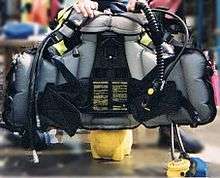 Jacket type BC on diving cylinder | |
| Acronym | BC or BCD |
|---|---|
| Other names | Buoyancy control device |
| Uses | To adjust and control the overall buoyancy of the diver |
| Related items | Backplate and wing |
They can be broadly classified as having the buoyancy primarily in front, surrounding the torso and behind the diver. This affects the ergonomics and to a lesser degree, the safety of the unit. They can also be broadly classified as having the buoyancy bladder as an integral part of the construction, or as a replaceable component supported inside the structural body.
The buoyancy compensator is one of the items of diving equipment most requiring skill and attention during operation, as control is entirely manual, and adjustment is required throughout the dive as weight reduces due to gas consumption, and buoyancy of the diving suit and BCD varies with depth. Fine buoyancy adjustment can be done by breath control on open circuit, reducing the amount of actual BCD volume adjustment needed, and a skilled diver will develop the ability to adjust volume to maintain neutral buoyancy while remaining aware of the surroundings and performing other tasks. The buoyancy compensator is both an important safety device when used correctly, and a significant hazard when misused.
The ability to control trim effectively is dependent on both appropriate buoyancy distribution and ballast weight distribution. This too is a skill acquired by practice, and is facilitated by minimising the required gas volume by correct weighting.
Function
The function of the buoyancy compensator is to allow the diver to adjust buoyancy underwater or at the surface within the range of slightly negative to slightly positive, to allow neutral buoyancy to be maintained throughout the depth range of the planned dive, and to compensate for changes in weight due to breathing gas consumption during the dive. Where staged cylinders are used, it may also be used to compensate for weight changes when dropping and retrieving these cylinders.
Components
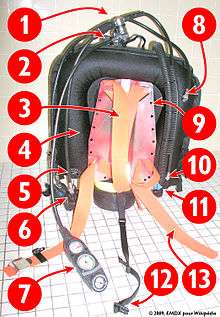
- Regulator first stage
- Cylinder valve
- Shoulder straps
- Buoyancy compensator bladder
- Relief and bottom manual dump valve
- Regulator second stages (with "octopus")
- Console (pressure gauge, depth gauge & compass)
- Dry-suit inflator hose
- Backplate
- BC inflator hose
- Oral inflation mouthpiece and manual dump valve
- Crotch strap
- Waist strap
All buoyancy compensators will have some components in common:
- A bladder to contain gas which may be added or released during the dive to control buoyancy.
- A means of adding gas to the bladder, generally a low pressure direct feed[1] or power inflator[2] that injects gas from a low pressure hose from the diving cylinder's diving regulator or an auxiliary cylinder to the bladder(s) of the BC, that is controlled by an inflation valve, and usually an oral inflation option. These are usually at the end of a corrugated or ribbed rubber inflation hose.
- A vent valve[1] or dump valve[2] that allows gas to be released or to escape in a controlled fashion from the bladder(s) of the BC. Most BCs have at least two vents: one at the extreme top and the other at the bottom of the BC, for use as air migrates to whichever part of the BC is uppermost, the vent situated at the shoulder is used when the diver is upright and the vent situated nearer the diver's waist is used when inverted. Venting through the oral inflation system is also usually possible.
- An over pressure relief valve that automatically vents the bladder if the diver over inflates the BC by ascending or by injecting too much gas. This is usually a secondary function of the vent or dump valve, and is a necessary safety feature to prevent over-pressure damage.
- A means of securing the BC to the diver to transfer buoyancy forces, and to hold the BC in the position intended for its designed function. The BC is typically secured to a diver's torso, either with dedicated straps or as part of a multi-functional system integrated with the bladder or casing.
In addition some BCs may include other features:
- A tough textile casing to contain and protect the bladder, and to which most of the other components are attached, with zippers for access to the bladders.
- Straps (cambands) to secure back-mount cylinders
- A plastic or metal backplate to support back-mount diving cylinders
- A crotch strap may be included in the harness to prevent the BC from sliding towards the head when the diver is upright and the bladder is inflated.
- A cummerbund is an alternative approach to reduce the tendency for the BC to slide towards the head by providing a close fit around the waist.
- Pockets for carrying small accessories or tools
- An integrated diving weighting system - pockets for lead weights with a quick release mechanism.[3] Integrated weights can eliminate the need for a separate weight belt.
- Trim weight pockets for adjusting the position of the diver's centre of gravity to improve diver trim.
- D-rings or other anchor points, for clipping on other equipment such as torches, pressure gauge, reels, cameras and stage, bailout or side-mount cylinders
- Emergency inflation cylinders. This can either be a small (about 0.5 litre) air cylinder, filled from the diver's main cylinder, or a small carbon dioxide cylinder.
- Reflective tape for better visibility.
- Padding for comfort.
- A redundant bladder with associated filling and venting components, as a backup in case of failure of the primary bladder.
- Alternative breathing gas regulator connected to or integrated with the inflation/deflation valve assembly.
- Bungees to restrain a partially inflated wing
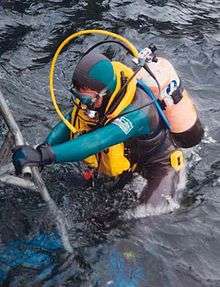
Types
There are three main types of BC based on buoyancy distribution:
Adjustable buoyancy life jacket
.jpg)
An adjustable buoyancy life jacket (ABLJ) is fitted around the neck and over the chest, secured by straps around the waist and usually between the legs. They are sometimes referred to as "horse collars" because of their resemblance, and are historically derived from the inflatable underwater demolition team (UDT) vest or Mae West life jacket issued to World War II flyers and divers.
They were developed in the 1960s and have been largely superseded by wing and vest type BCs, primarily because the buoyancy is concentrated in front of the diver when full, and behind the neck when partially filled, producing a tendency to shift the diver's center of buoyancy towards the head with inflation, which adversely affects the diver's trim underwater.[4] The ABLJ's location on the diver's chest and round the neck provides the best buoyancy distribution of the buoyancy compensater designs when it comes to floating a distressed, fatigued or unconscious diver face-up on the surface in the event of a problem.
The Dacor Seachute BC4 had unique upper and lower bladders. The upper bladder was around the neck and could be inflated by the CO2 cartridge for use as a surface life jacket. The lower bladder was over the diver's stomach area, and was inflated by LP gas from the regulator, for buoyancy control underwater. This arrangement provided better buoyancy distribution for trim control while diving than most other front inflation systems.[5]
Wraparound buoyancy BCs
Vest BC, stab jacket, stabiliser jacket, stab, waistcoat or (disparagingly) "Poodle Vest" BCs are inflatable vests worn by the diver around the upper torso, which incorporate the cylinder harness. The air bladder extends from the back around the diver's sides.
Wraparound bladders are favored by some divers because they make it easier to maintain upright attitude on the surface. However, some designs have a tendency to squeeze the diver's torso when inflated, and they are often bulky at the sides or front when fully inflated. Back inflation BCs are less bulky at the sides but may have a tendency to float the diver tilted forward on the surface depending on weight and buoyancy distribution, which presents a possible hazard in an emergency if the diver is unconscious or otherwise unable to keep his or her head above the water.
Vest BCs typically provide up to about 25 kilograms of buoyancy (depending on size) and are fairly comfortable to wear, if of the correct size and adjusted to fit the diver. Vest BCs are the most common type among recreational divers because they can integrate buoyancy control, weights, attachment points for auxiliary gear, and cylinder retention in a single piece of gear. The diver need only attach a cylinder and regulator set in order to have a complete scuba set. Some "tech-rec" (technical and recreational) vest BC's have the ability to carry multiple cylinders - Twin sets on the back, and sling cylinders at the sides, suspended from D-rings. The lack of flexibility of positioning the D-rings due to structural constraints on some designs is partly compensated by fitting larger numbers of D-rings, some of which may be in the right place for a given diver.
Three main wraparound configurations can be distinguished:
- The original stabilizer jacket patent by Scubapro featured a buoyancy bladder which allowed air flow around the arms and around the backpack - the trademarked 360° flow-through design. This was a complex bladder to manufacture.[6]
- Over-the-shoulder bladder, separated under the arms, which has a centre of buoyancy fairly high on the body when fully inflated, which tends to hold the diver upright at the surface. These are bulky over the front of the torso, particularly in the shoulder and chest area, and relatively clear to the sides under the arms.
- With extensions of the bladder from the lower back forward under the arms, but separated at the shoulders, and no buoyancy on the upper chest, which has a lower centre of buoyancy when fully inflated, and tends to tilt the diver backwards when fully inflated at the surface. These can be very bulky under the arms when integrated weighting and/or pockets are added, and for smaller waisted divers, also to the front of the waist area, but are relatively clear in the chest and shoulder area. The "shell" or bladder casing is usually separate from the cummerbund, which can be snugly fitted while leaving the bladder a relatively loose fit around the torso, to avoid restricting breathing when fully inflated.
BC attachment systems are generally intended to limit the shifting of the BC as a result of the lifting forces, including minimizing the tendency to slide towards the head when the diver is upright while the bladder is inflated. If the diver is wearing a weight belt, this will pull in the opposite direction to BC lift when the diver is upright, and can result in the diver sagging down in the jacket when floating at the surface. Solutions to this problem include the cummerbund (a broad adjustable waist band) and the crotch strap (a strap between the legs). The crotch strap, when adjusted correctly, is effective at preventing this shift, but may prevent the weight belt from falling clear of the diver if dropped in an emergency. Fitting the weight belt over the crotch strap after putting the BC on can be difficult. The cummerbund is an attempt to avoid this problem, as the weight belt can not be snagged on it in the same way, but the weight belt must then be worn either under the cummerbund, obstructing access to the buckle, or below the cummerbund. The effectiveness of a cummerbund depends on a waistline which is smaller than the circumference of the upper torso, and it may constrain free breathing if fitted too tightly.
This tendency of the inflated BC to shift towards the head is less of a problem when the weights are carried in integrated weight pockets on the BC, but it may then have a tendency to slide towards the head when deflated on an inverted diver underwater. This is less of a problem for the average recreational diver, who does not spend much time head down underwater, but can increase the difficulty of recovering from a dry-suit inversion where the air in the suit flows to the feet and the weights in the BC shift towards the head. A crotch strap will prevent this.
Back inflation
Back inflation buoyancy compensators are typified by the stainless steel backplate and wing arrangement popular with technical divers, but other arrangements are also available. Wings or Backplate and wing consist of an inflatable bladder worn between the diver's back and the cylinder(s). Invented by Greg Flanagan in 1979 for North Florida cave divers, and further developed by William Hogarth Main,[7] the back plate and wing configuration is not a recent development, but has gained popularity because of suitability for technical diving where it is often used, as the technical diver often carries multiple cylinders on his back and/or clipped to D-rings on the harness webbing. The bladder and cylinders or rebreather are fastened to a backplate which is strapped to the diver by the harness. The wing design frees the divers sides and front and allows for a large volume bladder with high lift capacity (60 lbs /30 liter wings are not uncommon). Some designs use elasticated webbing or bungee cords around the bladder to constrict the bladder when not inflated, although there is dispute regarding the safety and utility of this addition.[8] The distance between boltholes on the centreline of the backplate has standardised at 11 inches (280 mm) between centres.[7]
Other back inflation buoyancy compensators are more like the jacket style regarding the structure, attachment to the diver, and accessories, differing mainly in the bladder position, which is similar to a wing, being entirely behind the diver, without extensions to the sides or front.
A few short-lived rigid air compartment back inflation BCs were marketed in the 1970s.
A hybrid arrangement is also possible, which has most of the buoyancy in the back, but has a small amount to the sides below the arms.
- Diver wearing a wing buoyancy compensator
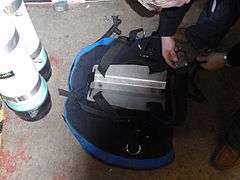 Wings for twin-cylinder set: the cylinders are fastened together by 2 metal bands which are bolted through the wing to the backplate
Wings for twin-cylinder set: the cylinders are fastened together by 2 metal bands which are bolted through the wing to the backplate- Bladder of a wing buoyancy compensator, showing the side which is away from the diver. The two pairs of slits allow use of cambands to hold a single cylinder
- Divers preparing for a decompression dive using backplate and wing with sling mounted decompression gas cylinders.
Sidemount BCDs
A variation on the back mounted buoyancy compensator is used without a backplate for side mount diving This arrangement is functionally similar to wearing the buoyancy compensator sandwiched between the cylinder(s) and backplate, but there is no backplate or back mounted cylinder. The buoyancy cell may be mounted between the sidemount harness and the diver, or on top of the harness.[9] The sides of the bladder may be restrained from floating upwards when inflated by bungee cords clipped to the waistband in front of the diver or clipped to each other, forming an elastic belt across the front of the hips, well below the diaphragm.
Some side mount harnesses are adaptable for use with a back mount cylinder as an option, without the rigid backplate.[9]
- Minimalist sidemount harness showing webbing, sliders and D-rings, buoyancy compensator, integrated weight holders and cylinder
- Top view of sidemount diver
- Sidemount diver in cave showing 2 cylinders and BC back view
- Combination sidemount/backmount harness. Front view
- Combination sidemount/backmount harness. Back view
- Apeks sidemount harness upper side
- Apeks sidemount harness underside
Construction
Buoyancy compensators of all types have been made in both single skin and casing and bladder arrangements. The strength and damage resistance of both these systems of construction depend more on the design details and quality of materials and manufacture than on the choice of arrangement, though maintenance may vary, as it is quicker to clean, dry and inspect a single skin than a bladder and casing, and the bladder and casing will have more components for an equivalent layout.
A single skin construction uses the material of the buoyancy bladder as the structural material for the unit, and a casing and bladder structure uses the casing for load bearing purposes and to protect the bladder, which is a replaceable part.
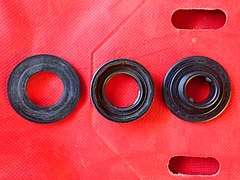 Components of a buoyancy compensator skin fitting
Components of a buoyancy compensator skin fitting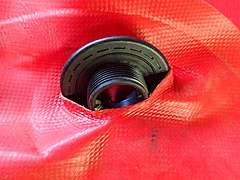 Internal fitting passing through the hole in a buoyancy compensator bladder
Internal fitting passing through the hole in a buoyancy compensator bladder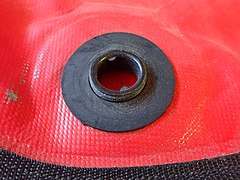 Buoyancy compensator internal fitting and gasket for filling hose or dump valve in place
Buoyancy compensator internal fitting and gasket for filling hose or dump valve in place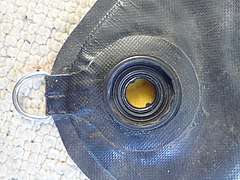 Corner of sidemount buoyancy compensator wing showing skin fitting assembled
Corner of sidemount buoyancy compensator wing showing skin fitting assembled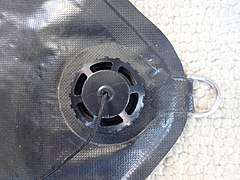 Corner of sidemount buoyancy compensator wing showing dump valve assembled
Corner of sidemount buoyancy compensator wing showing dump valve assembled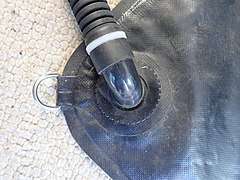 Corner of sidemount buoyancy compensator wing showing inflation hose attachment
Corner of sidemount buoyancy compensator wing showing inflation hose attachment
Operation
The buoyancy compensator is operated by adjusting the volume of gas contained in the bladder, using an inflation valve to inject gas and one or more deflation valves, or dump valves to release gas, which is usually supplied directly from a breathing gas cylinder, or orally, as exhaled gas, though dedicated gas cylinders can be used. At the surface, the bladder is inflated to provide positive buoyancy, allowing the diver to float in a preferred orientation, or deflated to let the diver start to sink to initiate a dive. During the dive, gas is added or dumped in much the same way to provide the desired buoyancy.
Size and fit
The buoyancy compensator must fit the diver comfortably and must stay securely in place without constraining the diver's freedom of movement. There is some conflict between allowing easy adjustment to fit a range of diver builds, and setting up the harness to optimum fit for a specific diver in a specific diving suit. This is a particular problem with jacket style BCDs which are inherently less adjustable for fit than backplate harnesses, which are more adjustable, but take more time to adjust.
It is critically important that the fully inflated buoyancy compensator can support the diver with the maximum equipment load on the surface at the start of a dive, and with maximum suit compression at the maximum depth before much gas is used up. There have been fatalities due to overloading the BCD. On the other hand, buoyancy control is easiest with the lowest practicable volume of gas in the BCD and dry suit, as these volumes change with depth changes, and must be adjusted to remain neutral.
It must be possible to remain neutral at the end of the dive, at the shallowest decompression stop, when almost all the diver's breathing gas has been used up. It is not sufficient to only be able to remain neutral with reserve gas, as if the reserve gas is nearly used up ue to a problem, the diver will not want to be struggling or unable to stay down to decompress.
Weighting must be sufficient to allow the diver to stay at the shallowest stop with empty cylinders, and available buoyancy volume must allow the BCD to support the full cylinders. The absolute minimum volume for the BCD is enough to support the total mass of breathing gas in all the cylinders the diver will carry, plus lost volume due to suit compression at depth. This will be enough only if the diver carries no excess weight. It is easier to allow for a slight weight excess and use a slightly larger volume BCD, but if taken to excess this will make buoyancy control more difficult and labour-intensive, and will use more gas, particularly during ascent when it is most critical. A BCD designed for recreational diving or for a small person may not have sufficient volume for technical diving.
An unnecessarily large volume BCD constitutes a greater risk of loss of control of ascent rate, particularly when combined with carrying more weight than is necessary to allow neutral buoyancy at the end of the dive with empty cylinders. On the other hand, a large volume gives greater comfort and security when floating at the surface before and after a dive.
Neutral buoyancy
The diver needs to be able to establish three states of buoyancy at different stages of a dive:[10]
- negative buoyancy: when the diver wants to descend or stay on the seabed. Recreational divers seldom need much buoyancy deficit, but commercial divers may need to be heavy to facilitate some kinds of work.
- neutral buoyancy: when the diver wants to remain at constant depth, with minimal effort. This is the desired state for most of a recreational dive.
- positive buoyancy: when the diver wants to float at the surface or ascend under some emergency circumstances.
To achieve negative buoyancy, divers who carry or wear buoyant equipment must be weighted to counteract the buoyancy of both the diver and the equipment.
When underwater, a diver often needs to be neutrally buoyant and neither sink nor rise. A state of neutral buoyancy exists when the weight of water that the diver and equipment displaces equals the total weight of the diver and equipment. The diver uses a BC to maintain this state of neutral buoyancy by adjusting the volume of gas in the BCD and therefore its buoyancy, in response to various effects, which alter the diver's overall volume or weight, primarily:
- If the diver's exposure suit is made of a compressible gas-filled material such as foamed Neoprene, the volume of the material will change (Boyle's Law) as the pressure changes when the diver descends and ascends.[11] The volume of air in the BC is adjusted to compensate for this.
- Gas contained in the flexible air spaces within the diver's body and equipment (including gas in the BC) is compressed on descent and expands on ascent. The diver normally counteracts this by adding gas to the space or drysuit, in order to avoid "squeeze".[11] Gas content in the BC is adjusted to correct buoyancy if these other corrections are not enough.[10]
- As the dive proceeds, gas is consumed from the diving cylinders of the breathing equipment. This represents a progressive loss of mass which makes the diver more buoyant; the diver's overall buoyancy must be reduced by venting air from the BC. For this reason the diver needs to configure his equipment to be a little overweight at the beginning of the dive so that neutral buoyancy can be achieved after the loss of the weight of the breathing gas.[12] Air or nitrox weighs about 1.3 grams for every litre at standard pressure. Thus, the magnitude of weight change from loss of air during a dive varies from roughly 4.3 kg (9.5 lbs) representing the total air content of a steel 15 litre cylinder at 230 bar/3500 psi (in practice, reserve requirements dictate that only about 8 lbs of this will be breathed if the dive goes to plan), to about 5 lbs difference for the smaller 80 ft3 aluminum-80 (AL80) tank (11.1 litres internal capacity) pressurised to 200 bar/3000 psi, and again assuming that only 5/6ths of the air in the tank is used, leaving a typical safety reserve.
In practice, the diver doesn't think about all this theory during the dive. To remain neutrally buoyant, gas is added to the BC when the diver is negative (too heavy), or vented from the BC when the diver is too buoyant (too light). There is no stable equilibrium position for a diver with any compressible gas space. Any change in depth from a position of neutral buoyancy and even small changes in volume, including the act of breathing, result in a force toward an even less neutral depth. Thus, maintenance of neutral buoyancy in scuba is a continuous and active procedure—the diving equivalent of balance, in a positive feedback environment. Fortunately, the diver's mass provides a source of inertia, as does the liquid medium, so small perturbations (such as from breathing) can be compensated for easily by an experienced diver.[10]
A feature of diving which is often non-intuitive for beginners, is that gas generally needs to be added to the BC when a diver descends in a controlled manner, and vented (removed or dumped) from the BC when the diver ascends in a controlled manner. This gas (added or vented) maintains the volume of the gas in the BC during depth changes; this bubble needs to remain at approximately constant volume for the diver to remain even approximately neutrally buoyant. When gas is not added to the BC during a descent, the gas in the BC decreases in volume due to the increasing pressure, resulting in a decrease in buoyancy and faster descent with greater depth, until the diver hits the bottom. The same runaway phenomenon, an example of positive feedback, can happen during ascent, resulting in uncontrolled ascent, until a diver prematurely surfaces without a safety (decompression) stop. This effect is greatest near the surface where volume change is greatest in proportion to depth change.
With practice, divers learn to minimize this problem, starting by minimizing the volume of gas required in their BC's. This is done by using the minimum weighting needed for their equipment, which keeps the volume of the gas in the BC as small as possible at the beginning of a dive. Just enough gas will be added tp the BC to compensate for the slow loss of weight as the dive progresses, as a result of gas use, which will vary according to the dive, but is limited by the cylinder contents. (in practice, for a recreational diver, this will be about 2 to 4.5 kilograms (4.4 to 9.9 lb) per cylinder).[10]
Somewhat complex trained reflex behaviors may be developed by experienced divers, involving breathing control and BC gas management during depth changes, which allow them to remain neutrally buoyant from minute to minute during a dive, without having to think much about it. Skilled scuba divers may be identified by their ability to maintain constant depth in horizontal trim, without fin use.
Orientation in the water
The vertical-horizontal orientation, or trim, of the submerged diver is influenced by the BC and by other buoyancy and weight components and contributed to by the diver's body, clothing and equipment. The scuba diver typically wishes to be trimmed nearly horizontally (prone) while under water, to be able to see and swim efficiently, but more nearly vertical and perhaps partly supine, to be able to breathe without a regulator when on the surface. Buoyancy and trim can significantly affect hydrodynamic drag on a diver and the effort required to swim. The effect of swimming with a head up angle, of about 15° as is quite common in poorly trimmed divers, can be an increase in drag in the order of 50%.[13]
The static and stable orientation of an object floating in water, such as a diver, is determined by its center of buoyancy and its center of mass. At stable equilibrium, they will be lined up by gravity and buoyancy with the center of buoyancy vertically above the center of mass. The diver's overall buoyancy and center of buoyancy can routinely be adjusted by altering the volume of the gas in the BC, lungs and diving suit. The diver's mass on a typical dive does not generally change by what seems like much (see above—a typical dive-resort "aluminum 80" tank at 207 bars (3,000 psi) contains about 2.8 kilograms (6.2 lb) of air or nitrox, of which about 2.3 kilograms (5.1 lb) is typically used in a dive, although any air spaces such as in the BC and in diving suits will expand and shrink with depth pressure. Larger changes in buoyancy are possible if the diving weights are jettisoned, or a heavy object is picked up.
Generally, the diver has a little control over the position of the center of buoyancy in the BC during a dive, the air in an incompletely inflated buoyancy compensator will rise to the shallowest part of the bladder unless prevented by a restriction to the flow. The position of this shallow point will depend on the diver trim and the geometry of the bladder. If the diver changes orientation in the water the gas will flow to the new high part if it does not have to flow down first to get there. as a result of this tendency, some buoyancy compensators will tend to hold the diver in the new position until actively changed. This is more likely in back mounted wing type bladders, where the gas can flow laterally to the high side and stay there. The diver can change the centre of gravity by adjustment of the equipment setup, which includes its configuration and position of weights, which ultimately influence where the effective BC lift is positioned relative to the Center of Gravity.[14]
Traditionally, weight belts or weight systems are worn with the weights on, or close to, the waist and are arranged with a quick release mechanism to allow them to be quickly jettisoned to provide extra buoyancy in an emergency. Weight carried on a belt can be distributed to shift the weight forward or backward to change the position of the diver's center of mass. Systems that integrate the weights into the BCD, can provide improved comfort so long as the BCD does not have to be removed from the body of the diver, for example in an underwater emergency such as an entanglement. When a weight integrated BCD is removed a diver wearing no weight-belt and any type of wetsuit or dry suit will be very buoyant.
By inflating the BC at the surface, a conscious diver may be able to easily float face-up, depending on their equipment configuration choices. A fatigued or unconscious diver can be made to float face up on the surface by adjustment of their buoyancy and weights so the buoyancy raises the top and front of the diver's body and the weights act on the lower and back of the body. An inflated horse-collar BC always provides this orientation, but an inflated vest or wing may float the diver face-down if the center of buoyancy is behind the centre of gravity. This floating orientation is generally considered undesirable and can be minimized by relocation of some of the weights further to the rear, and using higher density cylinders (typically steel), which also move the center of mass towards the back of the diver. The BC type can also be selected with this factor in mind, selecting a style with a center of buoyancy further forward when filled, as this has the same net effect. Any or all of these options can be utilized to trim the system out to its desired characteristics[15] and many factors can contribute, such as the number and position of diving cylinders, the type of diving suit, the position and size of stage cylinders, the size and shape of the diver's body and the wearing of ankle weights, or additional dive equipment. Each of these influence a diver's preferred orientation under the water (horizontal) and at the surface (vertical) to some degree.
Inflation gas supply and consumption
The usual inflation system is through a low-pressure hose from the primary breathing gas supply, but a dedicated direct feed pony bottle was common on early buoyancy compensators, and remains an option for some models. Most BCs allow oral inflation both underwater and on the surface. This could theoretically reduce gas consumption, but is generally not considered worth the effort and slightly increased hazard of taking the DV out of the mouth underwater, and possibly having to purge it before breathing again. Oral inflation is, however, an effective alternative inflation method in case of a failure of the pressurized inflation system. Emergency inflation by expendable CO2 cartridge is provided on some BCs.
Gas consumption varies depending on the dive profile and diver skill. The minimum consumption is by a diver who uses the correct amount to neutralize buoyancy and does not waste gas by overfilling, or by excessive weighting. The actual volume of the bladder should not affect gas consumption by a skilled user, as only enough gas to achieve neutral buoyancy is needed. Deep dives will require more gas, and dives in which the diver ascends and descends by large amounts and/or frequently, will require venting for each ascent and inflation for each descent. The amount of gas used during the dive during US Navy trials was generally below 6% of the total gas consumption,[5] and the use of small dedicated cylinders for inflation was considered adequate, but not necessary.
When used with a full-face mask or helmet, oral inflation becomes impracticable or impossible, and the reliability of the inflation system becomes safety-critical. Divers wearing dry suits have an alternative gas source available if the quick-connector systems for suit and BCD are compatible.
Hazards and malfunctions
Although a correctly fitted and competently operated buoyancy compensator is one of the most important items of equipment for diver safety, convenience and comfort, particularly for scuba divers, it is also a significant hazard if used wrongly or in case of some kinds of malfunction:
- There is a risk that an emergency inflation cylinder can be accidentally opened during a dive causing a rapid ascent and barotrauma to the diver. Carbon dioxide, being poisonous at high partial pressures, could be a dangerous gas to have in a BC because the diver may inhale it from the bag underwater.[16] The risk of this happening is low, as the diver would usually be aware that the emergency inflation has been operated, and divers are no longer trained to use the BC gas as an alternative breathing gas supply. Most BCs do not have a CO2 inflation option.
- Redundant bladders may be inadvertently filled, either by unintended action of the diver, or by malfunction of the filling mechanism, and if the failure is not recognized and dealt with promptly, this may result in a runaway uncontrolled ascent, with associated risk of decompression sickness. There is a risk that the diver will not recognise which bladder is full and attempt to dump from the wrong one. The risk can be reduced by ensuring that the filling mechanisms are clearly distinguishable by both feel and position, and not connecting a low pressure supply hose to the reserve until needed, so it is impossible to add gas by accident.
- Catastrophic bladder failure due to puncture, tearing or failure of the dump valve or inflation assembly can leave the diver with inadequate buoyancy to make a safe ascent, particularly if diving deep with large gas supply and insufficient ditchable weight. The risk can be mitigated by diving in a dry suit, which can be inflated to add buoyancy in an emergency, by carrying a DSMB, which can be deployed to provide a surface float, and by using distributed ditchable weights - ditching the whole weightbelt or too much weight may result in the opposite problem of excessive buoyancy and the inability to maintain neutral buoyancy at decompression stops.
- Inflator valve malfunction can inflate the bladder when the buoyancy is not needed, and if not recognized and dealt with promptly, can result in uncontrolled ascent with associated risk of decompression illness. This can happen more quickly with inflators combined with alternative demand valves as they must use a larger bore hose connector to be capable of supplying sufficient breathing gas at depth to a stressed diver. However, the standard overpressure and dump valves provided are able to vent air faster than the inflator valve can fill the bladder.[5] This can be mitigated by the ability to disconnect the inflator hose under pressure, a skill which is trained by some agencies.
- Ineffective or poorly adjusted cambands may let the cylinder slip and it may fall off the harness. Twin cambands provide redundancy against a camband being inadvertently released.
- Excessive gas volume, to compensate for overweighting or carrying heavy equipment, may increase in volume during ascent faster than the diver can vent and result in a runaway ascent, particularly with large volume BCs. This is avoided by using a bladder volume which matches the buoyancy requirements, and avoiding over-weighting.
- Some designs of BC combined with poor weight and buoyancy distribution may support an unconscious diver face down at the surface.[5]
- In some cases an excessively large jacket BC can cause an unconscious diver to be supported face down at the surface.[5]
- A loose-fitting BC without a crotch strap may slide up the diver and fail to keep his head out of the water at the surface, particularly in combination with a weight belt weighting system.
- A tight cummerbund may restrict the ability of the diver to breathe freely. As the work of breathing increases with depth this may result in ineffective ventilation leading to carbon dioxide buildup, toxicity, a desperate urge to breathe, hyperventilation and eventually panic. Panic underwater has been associated with many fatalities. A crotch strap eliminates the need for a cummerbund, but a cummerbund is more easily adjusted to fit the diver.
History
In 1957, F. G. Jensen and Willard F. Searle, Jr began testing methods for manual and automatic buoyancy compensation for the United States Navy Experimental Diving Unit (NEDU).[17] In their early tests, they determined that manual systems were more desirable due to the size of the automatic systems.[17] Later that year, the Walter Kidde and Co. sent a prototype buoyancy compensating tank for use with two cylinders to NEDU for evaluation.[18] The valves of this aluminium tank system leaked and testing was delayed until 1959 when it was recommended for field testing.[18]
The ABLJ was developed by Maurice Fenzy in 1961.[4] Early versions were inflated by mouth underwater. Later versions had their own air inflation cylinder. Some had carbon dioxide inflation cartridges (a holdover, for surface use, of the Mae West flyer's lifejacket) to facilitate emergency ascent. This was abandoned when valves that allowed divers to breathe from the BC's inflation bag were introduced. The Fenzy ABLJ provided a proof of concept for buoyancy compensation, however the large-volume ring behind the diver's neck caused the jacket to ride up against the diver's throat, despite the crotch strap.
In 1968, dive shop owners Joe Schuch and Jack Schammel developed a more comfortable buoyancy compensator vest that featured a smaller buoyancy ring behind the diver's head, and a midriff section with sufficient volume to lift the diver's head out of the water in the event that one or both of its CO2 cartridges were activated for emergency ascent. In 1969, the original Control Buoyancy Jacket or "CBJ" was manufactured by Waverly Air Products of Chemung, NY and sold in dive shops throughout the east coast of the United States. By 1970, a push-button inflator using air from the diver's SCUBA tank augmented the manual inflation hose.
Since 1970 most BCs have used for inflation mainly gas from one of the diver's main cylinders, and oral inflation tubes have been generally retained for contingency use (no high pressure gas left, malfunction of an inflator hose) both underwater and on the surface.
Scubapro introduced the stabilizer jacket in 1971, with a patented "360° flow through design", which allowed air to flow over the shoulders and under the arms, and around the cylinder mount.[19][20] Later products from competitors avoided patent infringement by eliminating some of the air path options, such as separating the bladder under the arms or over the shoulders.[6] These modifications also simplified the structure of the bladder. One of these later models was the Seatec Manta, with shoulder buckles and a softpac structure (without a rigid backpack)[6]
In 1972, Watergill developed the At Pac wing, the first wing-style BC, which was provided with a cummerbund and padded shoulder straps, and an integrated weight system.[6]
In 1985 Seaquest, Inc. introduced the Advanced Design Vest (ADV), a design featuring an under-arm wrap, shoulder buckles and a cummerbund. This design was duplicated by other manufacturers and continues to be produced as of 2013 [6]
Rigid shell back inflation buoyancy compensators were marketed by U.S Divers (UDS-I system) and Dacor (CV Nautilus)for a short period in the mid 70s. The Nautilus had an automatic inflation system using a regulator to maintain a constant volume, but the changes in buoyancy due to wetsuit compression and gas usage were not well compensated and the system never caught on.[6]
More recent innovations for jacket BCs include weight pouches to adjust trim, carrying the weights on the BC rather than on a weightbelt, integrated regulators, heavily reinforced 1050 denier ballistic nylon. Innovations for backplate and wing include redundant bladders, stainless steel backplates, lightweight soft nylon backplates, and 85 lb lift bladders. Some of these have improved safety or convenience.
Dive Rite marketed the first commercially manufactured backplates in 1984,[7] and a wing for diving twin cylinders in 1985. Other tech diving wing manufacturers include Ocean Management Systems, Halcyon, Apeks and Oxycheq. Other BC manufacturers include Sherwood, Zeagle, Scubapro, Mares, AP Diving and Cressisub.
See also
- List of inflatable manufactured goods – Links to Wikipedia articles on notable classes of inflatable goods
Other buoyancy related equipment
There are other types of equipment worn by divers that affect buoyancy:
- Backplate – Type of back-mount scuba harness
- Diving cylinder – High pressure compressed gas cylinder used to store and supply breathing gas for diving
- Diving weighting system – Ballast carried by underwater divers to counteract buoyancy
- Dry suit – Watertight clothing that seals the wearer from cold and hazardous liquids
- Wetsuit – Garment for water activities, providing thermal insulation but not designed to prevent water entering
References
- European terminology
- North American terminology
- "Mares SLS Slide And Lock Weight Pocket System". SDS Scuba Equipment. Retrieved 12 June 2018.
- Historicizing Lifestyle: Mediating Taste, Consumption and Identity from the 1900s to 1970s (Hardcover), Raptures of the Deep: Leisure, Lifestyle and Lure of Sixties Diving by Bill Osgeby ISBN 978-0-7546-4441-5
- Middleton, J. R. (1980). "Evaluation of Commercially Available Buoyancy Compensators". www.dtic.mil/. US Department of Defense Technical Information Center. Retrieved 5 June 2013.
- McLean, David. (2006) History of buoyancy compensators https://drive.google.com/?tab=wo&authuser=0#folders/0B3Z4b8qrjCTWSkJWd1N6YW5udTQ accessed 2 December 2013"Archived copy" (PDF). Archived from the original (PDF) on 2012-06-26. Retrieved 2011-12-22.CS1 maint: archived copy as title (link)
- Lunn, Rosemary E. (24 March 2016). "#TBT – How The 11 Inch Standard Was Born – By Rosemary E Lunn". TecRec Blog. Retrieved 1 January 2018.
- Discussion of Bungied Wings, aka Bondage Wings
- Kakuk, Brian; Heinerth, Jill (2010). Side Mount Profiles. High Springs, FL: Heinerth Productions. ISBN 978-0-9798789-5-4.
- Lippmann, John. "The Ups and Downs of Buoyancy Control". Divers Alert Network medical articles. Divers Alert Network S.E. Asia-Pacific. Retrieved 23 May 2016.
- Williams, Guy; Acott, Chris J. (2003). "Exposure suits: a review of thermal protection for the recreational diver". South Pacific Underwater Medicine Society Journal. 33 (1). ISSN 0813-1988. OCLC 16986801. Retrieved 2009-06-13.
- Fead, L (1979). "Is dropping your weight belt the right response?". South Pacific Underwater Medicine Society Journal (reprinted from: NAUI News, September 1978). 9 (1). ISSN 0813-1988. OCLC 16986801. Retrieved 2009-06-13.
- Passmore, M. A.; Rickers, G. (2002). "Drag levels and energy requirements on a SCUBA diver". Sports Engineering. Oxford, UK: Blackwell Science Ltd (5): 173–182.
- Swimming Position Centroid Calculation Methodology illustration from huntzinger.com
- Surface Buoyancy Moment Arm illustration from huntzinger.com
- http://www.emedmag.com/html/pre/tox/0500.asp Archived 2007-07-18 at the Wayback Machine CO2 Toxicity
- Jensen, FG; Searle, Willard F (1957). "Buoyancy Control of Open Circuit Scuba". United States Navy Experimental Diving Unit Technical Report. NEDU-RR-8-57. Retrieved 2009-06-13.
- Janney, G. M; Hanger, G. W (1960). "Walter Kiddie and Co. - Buoyancy Compensating Tank". United States Navy Experimental Diving Unit Technical Report. NEDU-Evaluation-7-60. Retrieved 2009-06-13.
- Hanauer, Eric (1994). Diving Pioneers: An Oral History of Diving in America. Aqua Quest Publications, Inc. ISBN 9780922769438.
- Krestovnikoff, Miranda; Halls, Monty (2008). Scuba Diving. Eyewitness Companions. Dorling Kindersley Ltd. ISBN 9781405334099.
Further reading
- Acott, Chris J. (1996). "An evaluation of buoyancy jacket safety in 1,000 diving incidents". South Pacific Underwater Medicine Society Journal. 26 (2). ISSN 0813-1988. OCLC 16986801. Retrieved 2009-06-13.
- Buoyancy compensator evaluations hosted by the Rubicon Foundation
- McLean, David: History of Buoyancy Compensators
External links
